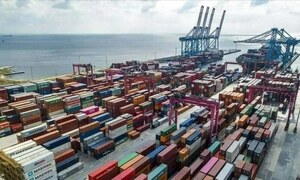The Philippines had its largest trade deficit on record in 2017, stoking concerns that its current account balance would deteriorate further and put more pressure on the already-weak peso. A surge in the trade gap was driven in part by imports of infrastructure-related goods as the government pushes ahead its ambitious plan to overhaul outdated railways and airports.
The trade deficit ballooned to $4.02 billion in December, a record for any month, from $3.84 billion in November, Philippine Statistics Agency data showed on Friday. That brought the full-year gap to $29.8 billion, from $26.7 billion in 2016, and added to the day's losses for the peso, the worst performing Asian currency against the dollar this year.
Following the trade data, the peso weakened to 51.79 against the US dollar. That took it close to 51.85, its lowest level since 2006, hit in October. This year, the peso has shed about 3.5 percent against the dollar.
"The record high trade deficit in December supports the view that PHP's (Philippine peso) weakness would also be norm as the trade deficit widens further," said Joey Cuyegkeng, economist at ING Bank in Manila said. In 2017, imports climbed 10.2 percent, due to increased purchases of mineral fuel, iron and steel, telecommunication equipment and electrical machinery, outpacing the 9.5 percent rise in exports.
Domestic demand, supported by fiscal stimulus and a monetary policy that is biased for growth, will continue to drive imports and lead to wider trade deficits, Cuyegkeng said, but the growth impact of a deteriorating trade balance should be offset by strong consumer and government spending. The central bank has forecast the Philippines in 2017 had a current account deficit of $100 million, its first since 2002, and sees this year's gap widening to $700 million. Data on 2017 is due on March 16.
The weakening current account position has led some economists to suggest the Philippines could be vulnerable if higher US interest rates spark capital outflows from Asia.
BR100
11,813
Decreased By
-53.2 (-0.45%)
BR30
35,707
Increased By
9.7 (0.03%)
KSE100
113,354
Decreased By
-794.3 (-0.7%)
KSE30
35,678
Decreased By
-274.1 (-0.76%)

























Comments
Comments are closed.